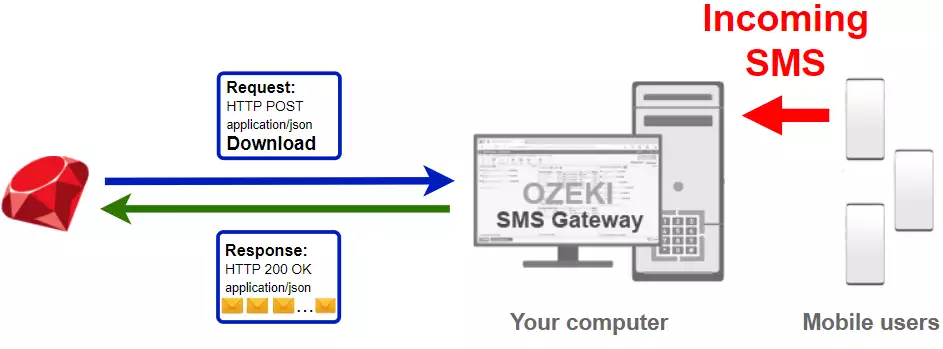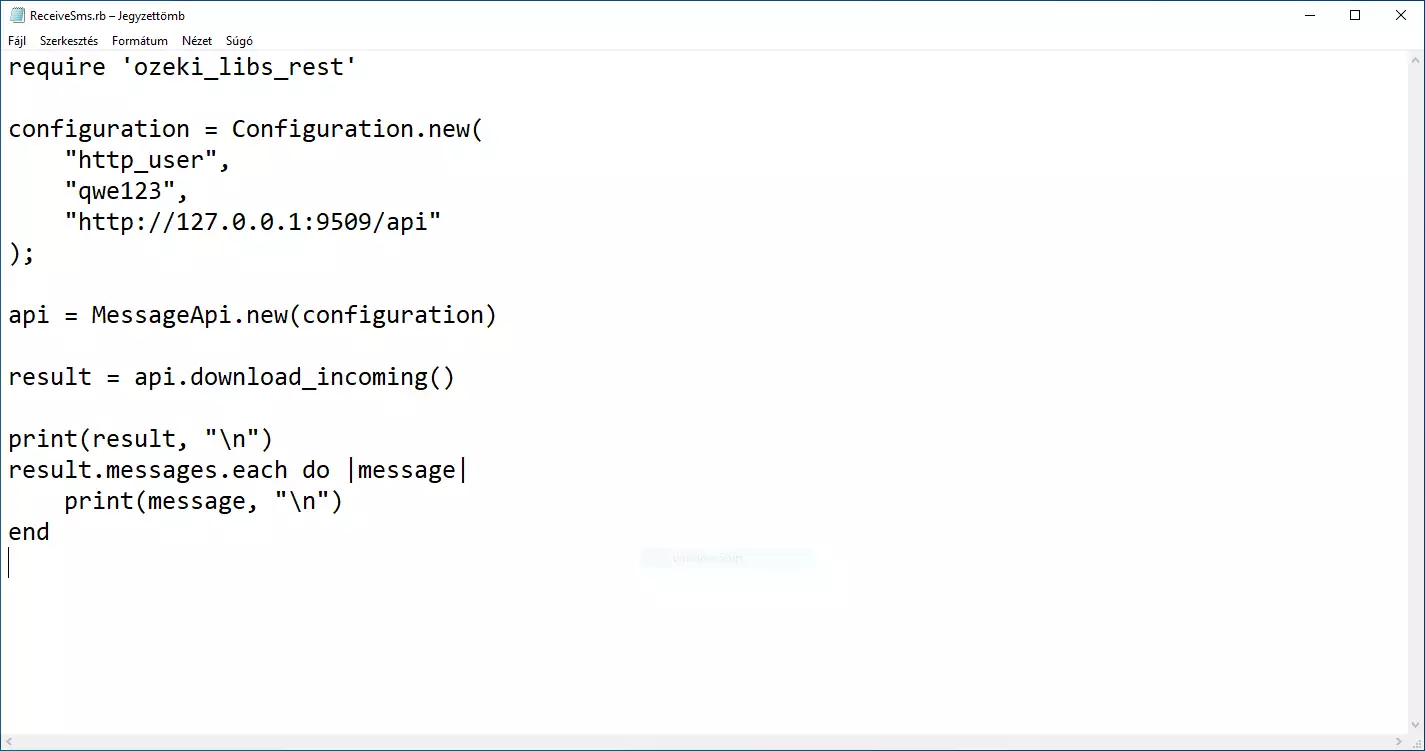How to receive SMS from Ruby
The simplest way to receive SMS messages from Ruby is to use the built in HTTP/Rest SMS api of Ozeki SMS Gateway. When you use this API, you will send SMS messages by issuing a HTTP Post request to the SMS gateway. The HTTP Post request will contain a message formatted in json format. The SMS gateway will send this SMS to the recipient's phone, and it will return a HTTP 200 OK response to your request.

Ruby code to receive sms messages
The Ruby sms code sample below demonstrates how you can send a scheduled SMS using the http rest sms api of Ozeki SMS Gateway using the Ruby ozeki_libs_rest gem. This library is provided to you free of charge, and you may use it and modify it in any of your projects.
ReceiveSms.rb
require 'ozeki_libs_rest'
configuration = Configuration.new(
"http_user",
"qwe123",
"http://127.0.0.1:9509/api"
);
api = MessageApi.new(configuration)
result = api.download_incoming()
print(result, "\n")
result.messages.each do |message|
print(message, "\n")
end
Download ReceiveSms.rb
The source code explained in this article can be downloaded and used and modified free of charge.
Download: ReceiveSms.rb.zip (319B)
What is in the ReceiveSms.rb.zip file?
The ReceiveSms.rb.zip contains the ReceiveSms.rb file, which contains the example code to show you how to send an SMS. This example code is listed below.

How to send a scheduled SMS from Ruby (Quick steps)
To send a scheduled SMS from Ruby:
- Download the ReceiveSms.rb.zip file
- Extract the .zip file from Downloads folder
- Open the ReceiveSms.rb file in any text editor like Windows Notepad
- Launch Ozeki SMS Gateway
- Create a HTTP API user in Ozeki
- Run ReceiveSms.rb Ruby code using the command prompt
- Check the Sent box in Ozeki SMS Gateway
Install Ozeki SMS Gateway and create an HTTP API user
To be able to send SMS from Ruby, first you need to install Ozeki SMS Gateway. The SMS gateway can be installed on the same computer, where you develop your Ruby code in Visual studio. After installation, the next step is to connect Ozeki SMS Gateway to the mobile network. You can send a test sms from the Ozeki GUI to verify, that your mobile network connection works. The final step to prepare your environment is to create a HTTP sms api user. Create a user with a username of "http_user", and with a password of "qwe123" to make the example work without modification.
After the environment is setup, you can run your Ruby code.
HTTP API url to use send sms from Ruby
To send SMS from Ruby, your Ruby will have to issue an HTTP request to the SMS gateway. The API url is shown below. Note that the IP address (127.0.0.1) should be replaced to the IP address of your SMS gateway. If Ozeki SMS Gateway is installed on the same computer where the Ruby sms application is running, this can be 127.0.0.1. If it is installed on a different computer, it should be the IP address of that computer.
http://127.0.0.1:9509/api?action=rest
HTTP authentication to use send sms from Ruby
To authenticate the Ruby sms client, you need to send the username and password in a base64 encoded string to the server in a HTTP request. The format used is: base64(username+":"+password). In Ruby you can use the following code to do this encoding:
username_password = username + ':' + password username_password_encoded = Base64.encode64(username_password) 'Basic ' + username_password_encoded
For example, if you encode the username 'http_user' and the password 'qwe123', you will get the following base64 encoded string: aHR0cF91c2VyOnF3ZTEyMw==. To send
HTTP request header to send SMS from Ruby
To send the SMS messages, you need to include the following lines as headers in the HTTP request. Note that we include a content type and an Authorization header.
Content-Type: application/json Authorization: Basic QWxhZGRpbjpvcGVuIHNlc2FtZQ==
HTTP request to send SMS from Ruby
To request your incoming SMS messages, your Ruby application will send an HTTP request similar to the one below. Note, that this request contains a HTTP header part only.
GET /api?action=receivemsg&folder=inbox HTTP/1.1 Accept: application/json Accept-Encoding: gzip;q=1.0,deflate;q=0.6,identity;q=0.3 Authorization: Basic aHR0cF91c2VyOnF3ZTEyMw== Host: 127.0.0.1:9509 User-Agent: Faraday v1.5.0
HTTP response received by the Ruby sms example
Once the SMS gateway receives this request, it will generate a HTTP response. The HTTP response will contain a status code, to indicate whether the SMS submit request was successful or not. It will also return a JSON encoded structure to provide you useful details about the messages.
HTTP/1.1 200 OK
User-Agent: OZEKI 10.3.123 (www.myozeki.com)
Content-Type: application/json; charset=utf8
Last-Modified: Tue, 06 Jul 2021 14:49:32 GMT
Server: 10/10.3.123
Transfer-Encoding: chunked
{
"http_code": 200,
"response_code": "SUCCESS",
"response_msg": "",
"data": {
"folder": "inbox",
"limit": "1000",
"data": [
{
"message_id": "4524cd1f-f048-4b78-99ec-37bd906e676d",
"from_connection": "http_user@localhost",
"from_address": "+36203333333",
"from_station": "%",
"to_connection": "http_user@localhost",
"to_address": "http_user",
"to_station": "%",
"text": "Hello world 3",
"create_date": "2021-07-06 14:47:37",
"valid_until": "2021-07-13 14:47:37",
"time_to_send": "2021-07-06 14:47:37",
"submit_report_requested": true,
"delivery_report_requested": false,
"view_report_requested": false,
"tags": [
{
"name": "Type",
"value": "SMS:TEXT"
}
]
},
{
"message_id": "e3125586-3d66-4f91-ac4e-66747653fe24",
"from_connection": "http_user@localhost",
"from_address": "+36202222222",
"from_station": "%",
"to_connection": "http_user@localhost",
"to_address": "http_user",
"to_station": "%",
"text": "Hello world 2",
"create_date": "2021-07-06 14:47:37",
"valid_until": "2021-07-13 14:47:37",
"time_to_send": "2021-07-06 14:47:37",
"submit_report_requested": true,
"delivery_report_requested": false,
"view_report_requested": false,
"tags": [
{
"name": "Type",
"value": "SMS:TEXT"
}
]
},
{
"message_id": "98895df5-4972-4941-8bf3-5fb0302d1fa8",
"from_connection": "http_user@localhost",
"from_address": "+36201111111",
"from_station": "%",
"to_connection": "http_user@localhost",
"to_address": "http_user",
"to_station": "%",
"text": "Hello world 1",
"create_date": "2021-07-06 14:47:37",
"valid_until": "2021-07-13 14:47:37",
"time_to_send": "2021-07-06 14:47:37",
"submit_report_requested": true,
"delivery_report_requested": false,
"view_report_requested": false,
"tags": [
{
"name": "Type",
"value": "SMS:TEXT"
}
]
}
]
}
}
Ruby sms example: ReceiveSms.rb
In this video, you will see the process of downloading the ReceiveSMS.rb from this tutorial page. It will start with the opened page and will end with the opened project. The video is only 30-seconds-long, but it contains all the information you need to download the example project. It is easy to understand and detailed. You will have no problem with the steps.
Example code
The example code below is part of the ReceiveSms.rb. If you are familiar with the Ruby programming language, feel free to modify the example project to your liking and send your first test message.

How to use the example project
In the following video, you will see how you can send a message using the example project. It will start with an opened notepad with the source code in it. At the end of the video, you will see the received messages. The video is only 1-minute-long, but you will learn all the steps you need to take to finish the process. The video is very detailed so you will have no problem with following the steps.
Summary
The purpose of this guide was to explain the steps of SMS receiving in Ruby with the help of Ozeki SMS Gateway. With a few simple steps, you can forward the messages from the inbox folder to a Ruby program. This solution is important if you want to collect these messages in separated place. Ozeki SMS Gateway allows you to manage SMS costs and to keep track of SMS traffic.
Make sure to continue the reading on Ozeki's tutorial page where more information can be found about similar topics, like SMS scheduling and multiple SMS sending in Ruby.
The only thing to do now is to download Ozeki SMS Gateway and let the work begin!
